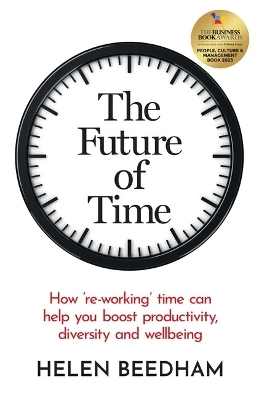
The Future of Time
Practical Inspiration Publishing (Verlag)
978-1-78860-263-1 (ISBN)
**Business Book Awards 2023: People, Culture & Management Book of the Year**
The way we value and manage time at work is broken.
Businesses are squandering time when making decisions, delivering work and managing people. Employees are rewarded for 24/7 availability, speed of response and hours worked.
The results are clear: low productivity; high stress and burnout; falling retention; and stalling diversity.
The Future of Time reveals how ‘re-working’ time – transforming organizations by adopting positive time practices – can help you build a more diverse, engaged and productive workforce.
Diagnostics to quickly assess the ‘time defects’ damaging your business
Compelling evidence, case studies and strategies to ‘re-work’ time successfully
Timelines and tools to bring about fast, effective change.
Helen Beedham, MA Cantab, speaks, consults and leads research on how to create more inclusive, productive workplaces where everyone can flourish. For the past 25 years, as management consultant then chair of a City-wide professional network, she has led change programmes for FTSE 100 businesses and regularly brought together Heads of HR, Diversity, Inclusion and Wellbeing to exchange market-leading practices.
Helen Beedham, MA Cantab, speaks, consults and leads research on how to create more inclusive, productive workplaces where everyone can flourish. For the past 25 years, as management consultant then chair of a City-wide professional network, she has led change programmes for FTSE 100 businesses and regularly brought together Heads of HR, Diversity, Inclusion and Wellbeing to exchange market-leading practices. www.helenbeedham.com
Table of Contents
Foreword
Introduction
A story about time
The path to here and now
‘The Future of Time’s central premise
How ‘The Future of Time’ will help you and your organization
Part 1: The ticking timebomb
How we’re collectively failing to manage time.
Chapter 1: Time today
How we value and treat time in business today
What knowledge-based businesses value now
How businesses typically value time
How we typically think about time at work
What we mean by collective time management
How we factor time into our decision-making
What our typical collective ‘time habits’ are
Chapter 2: Time blindness
Why we have developed time ‘blindspots’ in the workplace
What ‘time blindness’ is and why we aren’t talking about this
How time is ‘baked into’ our structures and processes
We mainly talk about time in terms of the working week & working patterns
Accepted, non-verbalised norms relating to time
How technology is helping/hindering
How time blindness manifests itself
Chapter 3: Time defects
How to recognise the signs of ‘broken’ time in your organization
Some verbal and visual indicators
How time defects affect employees generally
How they affect individuals
How we are valuing and measuring time wrongly
How we are being wasteful with time
Time defects: steady drip or major time fails?
What we are rewarding in the way we value and measure time
Chapter 4: Changing times
What’s influencing our wider relationship with time
o Big pressures impacting businesses that relate to time
o Major demographic factors affecting our approach to time
o How climate change is affecting our relationship with time
o Other factors influencing the way we run businesses today
o Social justice movements that are relevant here
o So what? What employers need to be paying attention to
Chapter 5: Out of time
How ‘broken’ time is hurting your business and why you need to act now
o The impact of ‘broken time’ on businesses
o How it is hurting productivity
o How it is impacting diversity and inclusion efforts
o The impact on employee engagement, motivation and retention
o The link to employee wellbeing
o Why this is urgent
Key points summarised
Part 2: Time re-worked
Better ways of valuing & managing time.
Chapter 6: Time reimagined
What the future of time looks like at work
o What the future could look like in broad terms
o How leaders could run businesses differently
o How commercials/financials could be managed
o How people could be managed
o What future working practices could look like
o What a more time-aware organization culture looks like
o Outcomes we would see
Chapter 7: Time solutions
The positive time practices that enable organizations to flourish
Ways we can be more ‘time aware’
Implications for leaders in their day-to-day choices and action
How teams can implement more time-aware practices
Time solutions for different kinds of work
Interpersonal relationships
Time-aware commercial practices
Time solutions that enable better employee wellbeing and more sustainable careers
Chapter 8: Time and talent
Implications for recruiting, managing and developing people
How we bring people into the organization
The jobs they do
Reflecting time-awareness in individual and team goals
HR, D&I and other workplace policies
How to build better time-awareness into people management
Pay and benefits
Time-aware careers
Chapter 9: Ahead of time
Organizations that are leading the way in managing time
Proof it’s possible to achieve this
What other organizations are successfully focusing on
4 case studies
Impact of their efforts so far
What they are learning that will help the reader
Key points summarised
Part 3: Time to act
How to re-work time in your organization
Chapter 10: Taking stock of time
How to diagnose your time defects and get time on the agenda
How to find out what your time defects are
How to gather evidence and create a burning platform
How to tell if it’s an emergency/how bad it is
How to get senior buy-in and support for addressing this
Chapter 11: Time strategies
How to tailor and implement your time solutions successfully
How to tackle it and how long it will take? Some principles
What you’ll need and how much it’ll cost
Where to start, how to prioritise, what order to adopt
What will help make/accelerate progress
3 implementation tools to help avoid reinventing the wheel
Pitfalls and setbacks to watch out for
How to assess progress
Chapter 12: Anchoring time
How to embed new time practices in your work culture
Why embedding matters
What embedding means - some examples
Who needs to do what to embed time practices
Specific embedding actions for productivity
Specific embedding actions for diversity
Specific embedding actions for wellbeing
After that, are we done? (no)
Chapter 13: Time toolkit (this may move into the Appendix)
Further resources to help you deal with challenges and stay on track
Agendas and/or checklist for business leaders, HR, D& I leaders, team managers, individuals ‘What can I do as …?’
Ongoing time check-ins
Ways to share and celebrate your time successes
Time solutions mini-library (e.g. ‘100 time solutions’)
Key points summarised
Conclusion
A closing story about time
Hopes for the future
‘Book on a page’ (1 page book summary)
Acknowledgements
Notes
Index
About the author
Join the ‘Future of Time’ community
| Erscheinungsdatum | 08.09.2021 |
|---|---|
| Verlagsort | Tadley |
| Sprache | englisch |
| Maße | 140 x 216 mm |
| Gewicht | 364 g |
| Themenwelt | Geisteswissenschaften ► Psychologie ► Arbeits- und Organisationspsychologie |
| Wirtschaft ► Betriebswirtschaft / Management ► Personalwesen | |
| Wirtschaft ► Betriebswirtschaft / Management ► Planung / Organisation | |
| Wirtschaft ► Betriebswirtschaft / Management ► Unternehmensführung / Management | |
| ISBN-10 | 1-78860-263-3 / 1788602633 |
| ISBN-13 | 978-1-78860-263-1 / 9781788602631 |
| Zustand | Neuware |
| Informationen gemäß Produktsicherheitsverordnung (GPSR) | |
| Haben Sie eine Frage zum Produkt? |
aus dem Bereich


